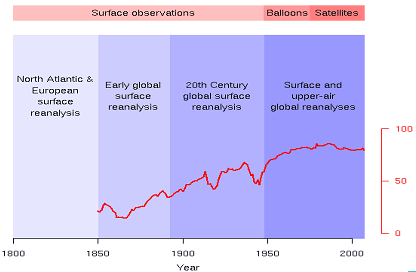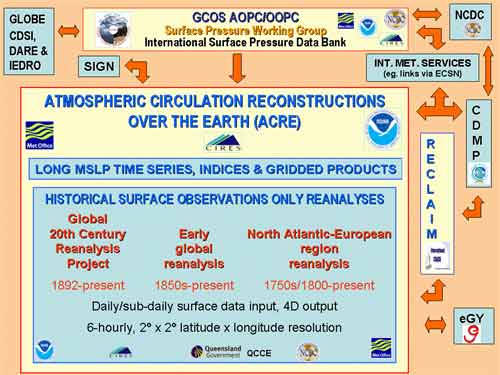Tiempo Climate Cyberlibrary
Interview with Rob Allan
- Tiempo archive
- Complete issues
- Selected articles
- Cartoons
- Climate treaty
- Latest news
- Secretariat
- National reports
- IPCC
About the Cyberlibrary
The Tiempo Climate Cyberlibrary was developed by Mick Kelly and Sarah Granich on behalf of the Stockholm Environment Institute and the International Institute for Environment and Development, with sponsorship from the Swedish International Development Cooperation Agency.
While every effort is made to ensure that information on this site, and on other sites that are referenced here, is accurate, no liability for loss or damage resulting from use of this information can be accepted.
 |
In a Newswatch interview, Rob Allan discusses new work aimed at extending the instrumental climate record that should benefit the scientific community, policy makers and everyday users of climate information. |
| Rob Allan is a member of the Climate Variability and Forecasting Group at the Hadley Centre of the United Kingdom Met Office in Exeter. He is project manager of the Atmospheric Circulation Reconstructions over the Earth (ACRE) initiative - a collaboration between the Queensland Climate Change Centre of Excellence in Australia, the Met Office Hadley Centre in the United Kingdom, and the National Oceanic and Atmospheric Administration (NOAA) Earth System Research Laboratory (ESRL) and the Cooperative Institute for Research in Environmental Sciences (CIRES), University of Colorado in Boulder, in the United States. | |
Tiempo Climate Newswatch: We now have weather stations covering most parts of the world, all reporting regularly and contributing to the global climate data bank. Why do we need additional data for the historic past?
Rob Allan: With the growing concern about climatic change, variability and extremes, there is an equally growing demand for reliable, high-quality and high-resolution historical instrumental observations of past weather and climate. These data are essential, as they vastly improve the statistical sample of the global climate system we can examine, thus enhancing our capacity to assess ocean-atmosphere model integrations and ultimately their simulation of anthropogenic effects on the climate. As a result, the global community will be far better placed to develop robust strategies for managing and responding to climate- and weather-related risks, and to better adapt to climate change.
Tiempo Climate Newswatch: Is there much data available that hasn't already been incorporated in the major climate data banks?
Rob Allan: In seeking observational evidence for climate change, large amounts of historical observational data have been addressed. Even so, equally large amounts of data remain untapped. In fact, there are considerable terrestrial and marine data around the world which are still in hard copy form and have not been digitized and taken into international climate data banks.
Many developing countries are not fully aware of the extent of colonial observations made across their territories in the past, or do not have the finances, personnel or infrastructure to have such data imaged and digitized. In fact, the climate of remote areas of the planet has been severely under-sampled until very recently. This is even more evident with regard to the upper air structure of the atmosphere. The overall situation is highlighted by the heavy red trace in the figure (Figure 1), which illustrates the percentage of the globe covered by the most abundant data, digitized surface observations, back through time.
 |
| Figure 1: Schematic of global terrestrial and marine data coverage since 1800 and the reanalyses which have used all available surface, meteorological balloon, aircraft and satellite observations since the late 1940s (i.e. those produced by the National Centers for Environmental Prediction and the European Centre for Medium-Range Weather Forecasting) (darkest blue), together with the series of surface-observations-only ACRE-facilitated historical reanalyses (in lighter shades of blue going back in time). The thick red line shows the percentage of the globe covered by digitized surface observational data (%), with prominent dips in coverage during the first half of the 1940s and the 1910s, during periods of widespread conflict, and little data prior to 1850. |
Tiempo Climate Newswatch: How far back in time can you go?
Rob Allan: For major instrumentally-measured variables, such as air temperature, precipitation and atmospheric pressure, it is possible to find records for individual sites in the "old world" that can be extended back to cover the past 300 years or so. Some of these have been measured on daily to sub-daily timescales. Other variables, such as cloudiness, wind and humidity, have not received the same amount of attention, usually because they are very challenging to either measure consistently back through time, quality control or homogenize. Nevertheless, projects such as the Climatological Database for the World's Oceans 1750-1850 have shown the immense potential of both historical instrumental and non-instrumental wind observations over the globe.
Over the North Atlantic-European region, it is possible to recover enough high-resolution instrumental observations from terrestrial and marine sources to produce gridded data sets of the major variables going back into the early to mid-18th century. Near-global data coverage is possible back to the 1830-50s, though large parts of the interiors of the major Southern Hemisphere continents have little or no observations. Certainly, the longer marine coverage allows for gridded sea surface temperature and atmospheric pressure to be reconstructed over much of the world's oceans for the past 150 to 170 years.
Complicating this situation further, is that often the focus for data recovery and digitization has been on observations of air temperature and precipitation made solely by National Meteorological Services (NMS), the earliest which began in the early to mid-1800s. Even so, there are large amounts of such NMS data, particularly from the old colonial domains of the major European nations, which have received little or no attention - particularly observations taken on daily to sub-daily timescales. With variables such as atmospheric pressure, the situation is most acute.
Tiempo Climate Newswatch: It sounds like the developing world warrants considerable attention, with data available but paper records often decaying in archives. Are we devoting enough resources to "data rescue" in developing nations?
Rob Allan: The simple answer is no. Important data rescue efforts focusing on developing countries around the world exist, but often just barely. These activities are generally lacking in ongoing funding support, personnel and overall infrastructure.
Just to highlight a few of these situations.
Australian and New Zealand NMSs are leading a Pacific Islands climate data rescue project to save and preserve meteorological observations from that region. However, this project needs ongoing funding to enable its rescue, preservation, digitization and archiving efforts to cover the full historical extent of such material. Much of the earliest data is held in the colonial records of the United Kingdom, Germany and France.
The International Environmental Data Rescue Organization (IEDRO), a non-profit organization based in the United States, is an initiative to collect and put into digital form weather observations from countries around the globe that need help with such activities. This benefits both the countries involved and improves global climate databases for international understanding of climatic variability and change issues and impacts. IEDRO has undertaken this work on surface and upper-air data in conjunction with the NMS and other institutions in Kenya, Malawi, Mozambique, Niger, Senegal and Zambia in Africa and Nicaragua, Dominican Republic, Chile and Uruguay in the Americas. Ironically, IEDRO is currently under pressure with regard to its funding. We're not talking big monies, but there is a chance that IEDRO may simply cease to be.
Projects such as MEditerranean climate DAta REscue (MEDARE), and the Mediterranean CLImate VARiability and Predictability (MedCLIVAR) initiative are trying to establish and fund coherent data rescue missions across the wider Mediterranean region, in which important records from North Africa and the Middle East will be recovered and digitized. These actions have the backing of bodies such as the World Meteorological Organization, but no real monies are available to support them.
With minimal funding, the Atmospheric Circulation Reconstructions over the Earth - ACRE - initiative, which I manage, is working with various institutions, NMS and university groups to develop ongoing data rescue, imaging and digitization projects for the South China Sea-South East Asian region and for the greater European region. It also has a specific undertaking with MeteoFrance to recover and digitize old daily to sub-daily French colonial observations from around the globe.
Tiempo Climate Newswatch: It's not just a matter of collecting the data, is it? The improved data bank can be used to reconstruct the wind systems of the planet through a process known as reanalysis.
Rob Allan: Climate reanalysis is an important new tool that creates dynamically-coherent climatic reconstructions of the global climate system, which can be used to study the processes which drive climatic variability and change. It is a technique in which global daily to sub-daily observations for a period in the past are assimilated into a modern-day numerical weather forecast model, which uses this information and the known physics of the climate system to create three dimensional (3D) gridded and spatially-complete weather variables over the planet. The products generated by reanalysis do not suffer from inhomogeneities caused by changes in the data assimilation system, but are, of course, only as good as the quality and quantity of data assimilated by the reanalysis process.
Until recently, reanalyses assimilated all available observational data, covering surface to upper atmosphere observations made by terrestrial and marine platforms, aircraft, meteorological balloons and satellites. The two most widely used of these reanalyses are those generated by the National Centers for Environmental Prediction (NCEP) in the United States and the European Centre for Medium-Range Weather Forecasting (ECMWF) for the post World War 2 period (as in the figure).
However, new developments and research by our collaborators in the ACRE initiative, Gil Compo and Jeff Whitaker of the NOAA/ESRL and CIRES, University of Colorado, with the 20th Century Reanalysis Project, have shown that it is possible to perform a reanalysis which can generate 3D weather variables throughout the depth of the atmosphere by assimilating only surface observations over the globe. Given that surface observations are the longest measures of the state of the climate system, a reanalysis using such data will extend our ability to reconstruct the global climate: that is, up to three times the length of current NCEP or ECMWF reanalyses.
Tiempo Climate Newswatch: That's very exciting. But just how can weather data from the Earth's surface give you information about winds high above the ground?
Rob Allan: The dynamics and thermodynamics of the atmosphere link variations at the surface and aloft. The link is so strong that with a good numerical weather prediction model and an advanced method for using the surface information in our United States collaborators' reanalysis techniques, they can successfully infer the weather variations at the jet stream level, high in the atmosphere, from variations at the Earth's surface.
The results of initial testing of preliminary 3D weather variables by our 20th Century Reanalysis Project collaborators are extremely encouraging. Comparisons between gridpoint reanalyses and weather balloon-observed atmospheric temperature and geopotential height surfaces for the same location at the 700, 500 and 300 hPa levels reveal very high correlations of between +0.87 and +0.97, explaining between 76 and 94 per cent of the variance.
Tiempo Climate Newswatch: What improvements in understanding are likely when we have this long record of the atmospheric circulation?
Rob Allan: The ACRE-facilitated reanalyses will produce the longest global database of reconstructed 3D atmospheric weather conditions to date. This database will provide a climate quality reanalysis product, downscaled so that researchers and a myriad of users can evaluate and revaluate climatic variability and climate change influences, impacts and modulations on the environment, society, resources and infrastructures on global through to regional and local scales.
The climate quality reanalyses will help researchers learn more about the evolving spatial and temporal structure of specific atmospheric circulation phenomena in the climate system, such as the El Niño Southern Oscillation phenomenon, the Madden-Julian Oscillation, the Antarctic Oscillation/Southern Annular Mode, the Arctic Oscillation/Northern Annular Mode, and the North Atlantic Oscillation. This will make it possible to address the nature, intensity and frequency of climatic impacts such as floods, storms and droughts in ways and over time spans not previously possible.
Tiempo Climate Newswatch: What's the specific role of the ACRE project?
Rob Allan: The Atmospheric Circulation Reconstructions over the Earth initiative is an "end-to-end" project, which facilitates both the historical global weather observational data needs of pioneering surface-observations-only climate quality reanalyses and the seamless feeding of 3D weather products produced by these reanalyses into climate applications and impacts models.
The long historical terrestrial and marine weather observations assembled and digitized by ACRE will be used to generate new surface-observations-only reanalyses, producing a 56 member ensemble every six hours of two degree latitude by two degree longitude resolution, global 3D tropospheric weather variables.
ACRE is facilitating the data requirements for three historical climate quality reanalyses:
- the ongoing 20th Century Reanalysis Project (1892 to present);
- an early to mid-19th Century Reanalysis (1830s/1850s to present); and,
- a North Atlantic-European Region mid-18th Century Reanalysis (1750s to present).
Tiempo Climate Newswatch: Can Tiempo readers make a contribution?
Rob Allan: Yes, Tiempo readers could encourage researchers, research institutes and the NMS in their countries to work with ACRE to rescue, image and digitize daily to sub-daily surface weather variables.
ACRE would also be very keen to hear from those who might be interested in using any of the reanalysis products it is helping to develop. Such outputs can be tailored or downscaled to seamlessly flow into various climate applications, biophysical and production models.
In fact, ACRE is particularly keen that these reanalyses products and their climate applications are taken up and applied by agencies, institutions, governments and NMS in developing countries. To facilitate this process, ACRE is aiming to hold workshops, or link with other planned workshops, in or near developing regions around the globe.
Tiempo Climate Newswatch: What benefits are we likely to see out in the real world as a result of this work?
Rob Allan: The ranges of uses that can be made of ACRE-facilitated historical climate quality reanalyses are enormous. They include a long historical database of 3D weather variables needed in various primary production, economic and hydrological models for both the developed world and in developing counties. It will be possible to undertake assessments and modelling of the intensity and frequency of extremes, such as floods, storminess, storm surges and droughts, and their costs to society and governments, in ways not previously possible.
A wide range of weather variables impacting on health issues, such as cold snaps or heat waves, epidemics and pandemics (for example, influenza, avian flu) can be generated. The data could be used to assess impacts on commercial activities and business applications, including climate-dependent industry sectors such as energy, for supply/demand assessment, for example, and wind power generation, agriculture and forestry, fisheries, water resource management, and insurance/reinsurance. Commercial ventures such as marine salvage, off-shore oil and gas exploration and wind and wave power generation will find the data useful.
We will have improved historical datasets for the purposes of climate studies, their application to observational and model-based studies of climate variations, and up-to-date climate information for users as well as an improved capacity to assess ocean-atmosphere model integrations simulating anthropogenic effects on the climate for future Intergovernmental Panel on Climate Change assessment reports. We'll learn more about the typical climate variability of sparsely-observed regions in order to better understand some of the limitations of the climate models we are currently using.
Finally, we'll be able to provide improved, quantitative and reliable advice to governments and the public on climate and its variations.
Tiempo Climate Newswatch: Thank you for your time.
Further information
Rob Allan, ACRE Project Manager, Met Office, FitzRoy Road, Exeter EX1 3PB, United Kingdom. Fax: +44-1392885681. Email: rob.allan@metoffice.gov.uk. Web: brohan.org/hadobs/acre/acre.html.
Bright Ideas

General Electric plans to cut solar installation costs by half

Project 90 by 2030 supports South African school children and managers reduce their carbon footprint through its Club programme

Bath & North East Somerset Council in the United Kingdom has installed smart LED carriageway lighting that automatically adjusts to light and traffic levels

The United States National Oceanic and Atmospheric Administration and the American Public Gardens Association are mounting an educational exhibit at Longwood Gardens showing the link between temperature and planting zones

The energy-efficient Crowne Plaza Copenhagen Towers hotel is powered by renewable and sustainable sources, including integrated solar photovoltaics and guest-powered bicycles
El Hierro, one of the Canary Islands, plans to generate 80 per cent of its energy from renewable sources

The green roof on the Remarkables Primary School in New Zealand reduces stormwater runoff, provides insulation and doubles as an outdoor classroom

The Weather Info for All project aims to roll out up to five thousand automatic weather observation stations throughout Africa

SolSource turns its own waste heat into electricity or stores it in thermal fabrics, harnessing the sun's energy for cooking and electricity for low-income families

The Wave House uses vegetation for its architectural and environmental qualities, and especially in terms of thermal insulation

The Mbale compost-processing plant in Uganda produces cheaper fertilizer and reduces greenhouse gas emissions

At Casa Grande, Frito-Lay has reduced energy consumption by nearly a fifth since 2006 by, amongst other things, installing a heat recovery system to preheat cooking oil
Updated: May 15th 2015
